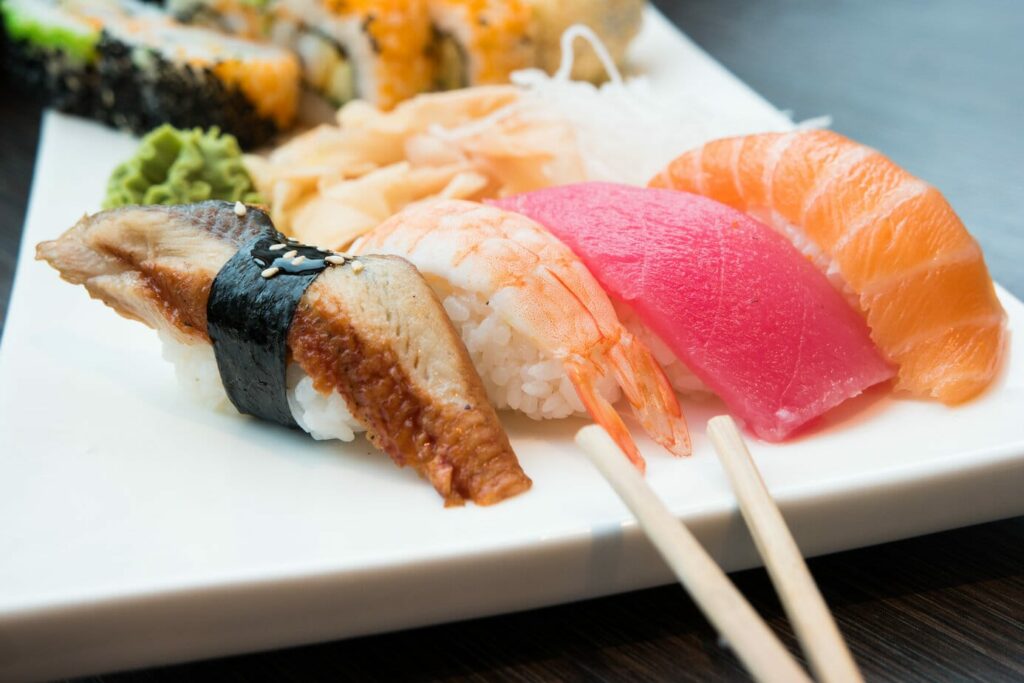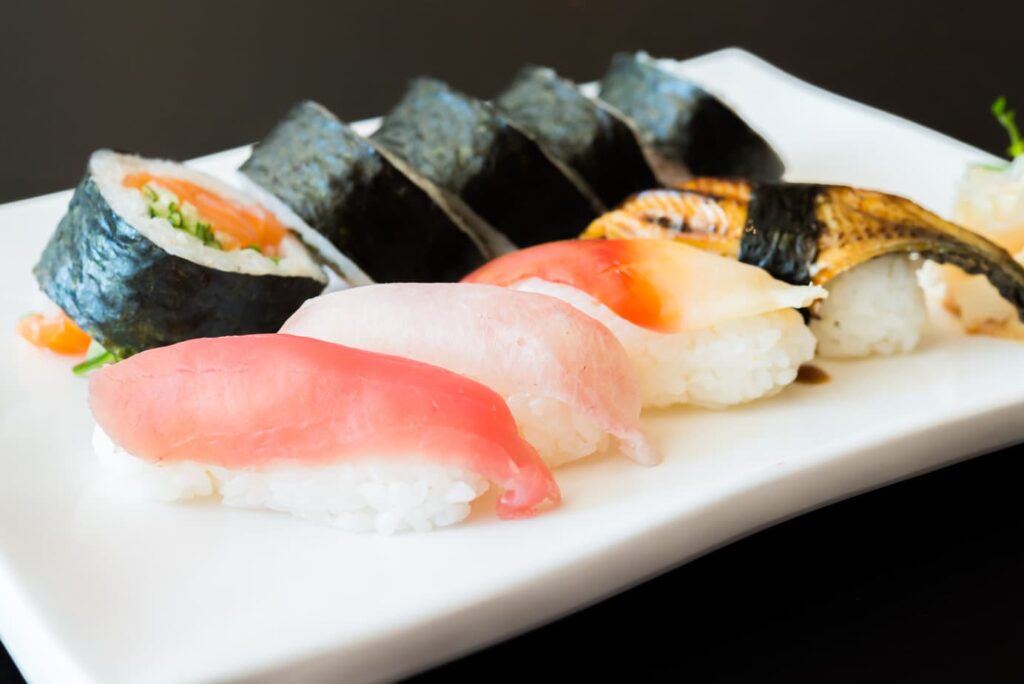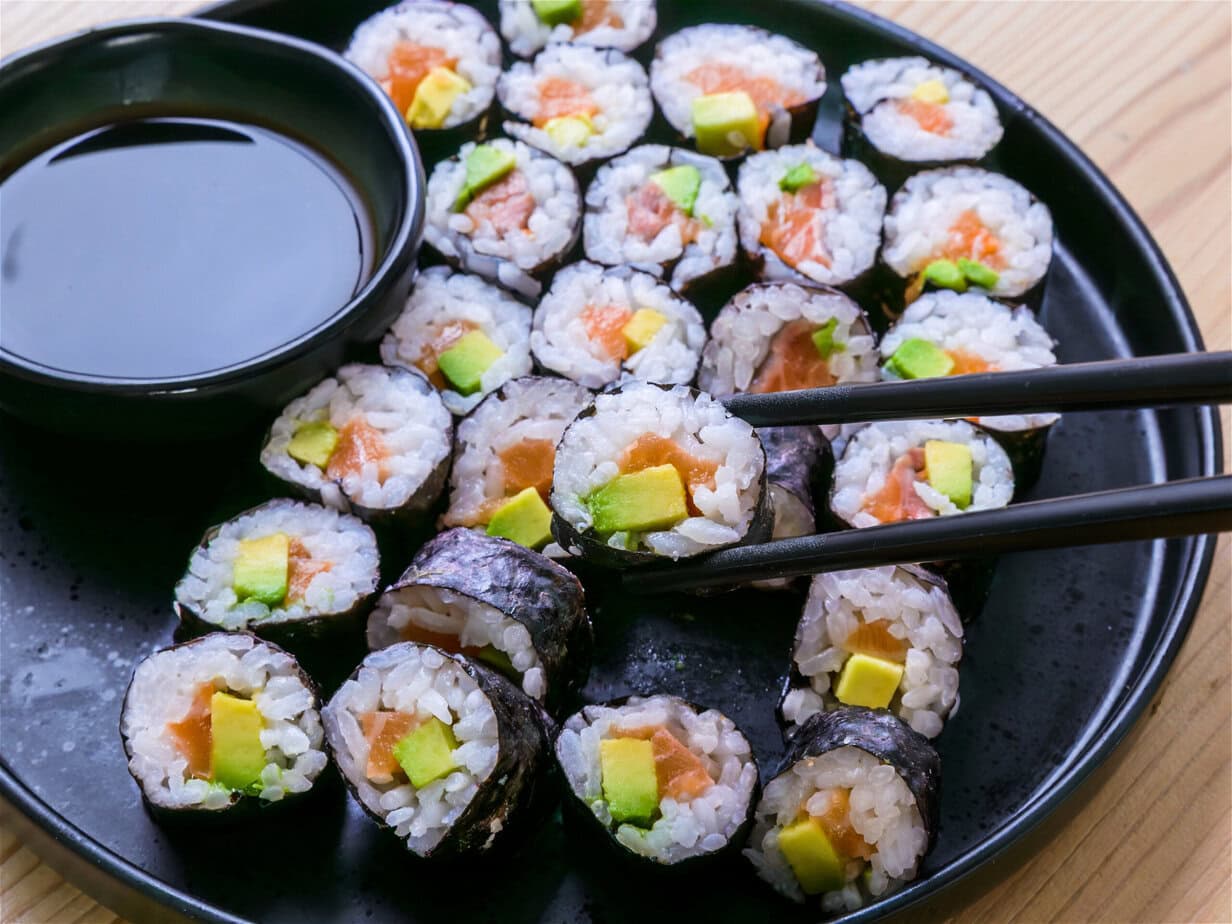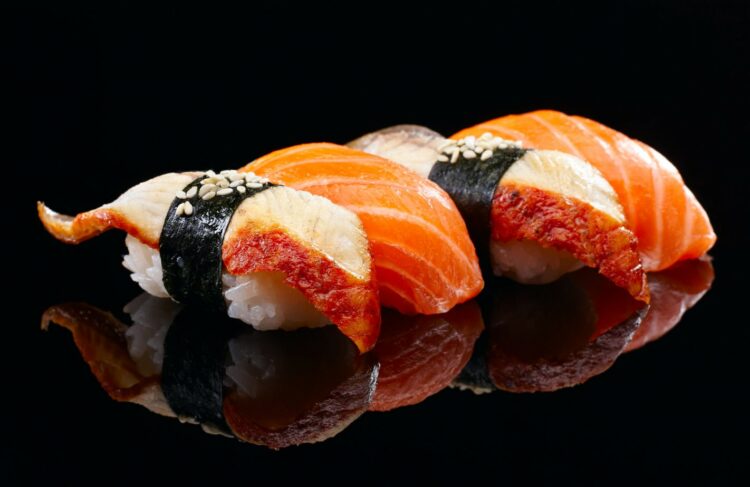One of the wonderful things about sushi (or even Japanese cuisine in general) is that you don’t need to know the name of every little variety to enjoy it. This is especially true if you go to conveyor belt sushi restaurants, where you’re free to pick any dish that catches your eye.
But if you’re ordering from a menu, it helps to be at least somewhat familiar with the main types of sushi, so you have a rough idea of what you’ll get if you order each one. And in Japan, at least, the most popular type of sushi is called nigiri.

What is sushi?
But first, what exactly is sushi? At its core, sushi is a Japanese dish made with specially prepared rice, combined with another ingredient—usually some kind of fish or seafood, often raw but sometimes cooked.
Sushi can be made in several different ways, but it always includes rice—and even though the word sushi is often automatically linked to raw fish, it’s not wrong to say that the main ingredient in sushi is vinegared rice. In fact, the word “sushi” is a blend of the Japanese words for vinegar and rice. The toppings may change, but sushi always includes rice.
Sushi rice is a pretty deep topic, and sushi chefs in Japan spend years training just to learn how to make sushi rice before they ever pick up a knife to start slicing fish.
But in short, sushi rice is a medium-grain white rice that’s prepared with vinegar and other seasonings (salt and sugar). When it’s made properly, sushi rice has a sticky texture that allows it to be shaped or rolled.
What is nigiri sushi?
That brings us to nigiri. Nigiri sushi is that very common style of sushi made with an oval-shaped mound of rice topped with a slice of (usually) raw fish. The word nigiri comes from the Japanese nigirizushi, which means “hand-pressed sushi.” Just like temaki, there’s no need for a bamboo mat!
So, nigiri is a type of sushi where the rice is shaped by hand and the fish or other topping is pressed by hand onto the rice. And it’s the stickiness of the rice, combined with the moisture from the topping, that helps the strip of raw fish stick to the mound of rice underneath.

Sometimes, the chef will put a small amount of wasabi between the rice and the fish, and it’s also common to see toppings like chopped green onions or ginger placed on the fish.
The fish is almost always raw. Typical examples include tuna, salmon, yellowtail, and albacore. Fatty tuna, which comes from the belly section of bluefin tuna, is another popular topping.
A few notable exceptions to the “almost always raw” rule include shrimp nigiri, which uses boiled and butterflied shrimp, and eel nigiri, which is a mound of sushi rice topped with a strip of grilled eel.
Whether cooked or raw, the fish and seafood for nigiri—and really for all sushi—must be extremely fresh and handled with great care.
While sushi restaurants do provide chopsticks, the preferred way to eat sushi is to pick it up with your fingers and eat each piece in one bite. Sushi etiquette is a whole other huge topic we can’t fully cover here, but in general, nigiri should be dipped in soy sauce so that the fish, not the rice, is immersed, and eaten upside down, with the fish against your tongue.
The reason for dipping the fish side down is so the rice doesn’t soak up too much soy sauce, and to keep grains of rice out of the soy sauce dish.
Nigiri vs. maki
Nigiri sushi is different from what is, at least in Europe, the most popular type of sushi—the rolled style known as maki.
Maki sushi is shaped like a tube, held together by a sheet of dried seaweed called nori, with a layer of rice and then a layer of fillings, which can include things like raw fish, cooked shellfish, vegetables, and even Philadelphia cream cheese.

The rolled tube is then cut into individual bite-sized pieces. Sometimes, the roll is made inside out so the rice is on the outside, and versions with a thin strip of fish, eel, or shrimp on the outside are also common. Like nigiri, maki is also best eaten with your hands.
Nigiri vs. sashimi
Another common item at Japanese sushi restaurants is sashimi, which is simply strips of raw fish served without any rice at all (though rice may be served alongside sashimi).
As such, sashimi isn’t technically a type of sushi since sushi, by definition, always contains rice. But you can think of nigiri sushi as a mound of hand-pressed rice with a strip of sashimi on top. Unlike nigiri and maki, sashimi is eaten with chopsticks.
Different types of nigiri sushi
In addition to the main type of nigiri sushi described above, there’s something called gunkan-maki. Gunkan-maki is a type of nigiri with a soft or semi-liquid topping, like chopped tuna, fish roe, or sea urchin.
What makes gunkan-maki different is that it has a strip of nori wrapped around the outside of the rice mound, making it look like a battleship. The top edge extends above the rice, forming a kind of bowl or container that holds the topping in place.
Another variation or sub-type of nigiri is known as nori-tied nigiri, where the topping is secured to the rice mound with a thin strip of nori that’s wrapped or attached vertically around the nigiri. This is done when the topping doesn’t have enough moisture to stick properly to the rice. Unagi sushi is made with strips of grilled or simmered eel, and tamagoyaki sushi is topped with a sweet omelet.
Nigiri recipe

Ingredients
Nigiri Basics
- Sushi rice
- Sushi rice seasoning Click for the recipe
- Wasabi
- Pickled ginger
- Light soy sauce
- sheets nori
Most Popular Toppings
- Sushi-grade salmon
- Sushi-grade tuna
- Cooked shrimp
- Octopus
- Uni sea urchin
Instructions
- Rinse the rice under cold water, then add it to the rice cooker with water.Sushi rice
- Cook the rice until tender, then transfer to a bowl to cool slightly.
- Season the rice with the sushi seasoning.Sushi rice seasoning
- Prepare the toppings by cutting them into strips about 5 to 6 cm long.Sushi-grade salmon, Sushi-grade tuna, Cooked shrimp, Octopus, Uni
- Scoop about 3 tablespoons of rice and press it into an oval in your hand.
- Place the topping of your choice on the rice.
- If desired, wrap a thin strip of nori around each nigiri to hold the rice and topping together.sheets nori
- Serve with wasabi, pickled ginger, and soy sauce to taste.Wasabi, Pickled ginger, Light soy sauce

